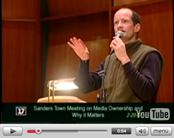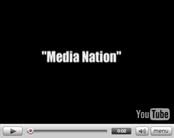Discuss E-List
Essential Resources Guide
FREE Teaching Resources
Membership Benefits
Partner Discounts
Summit 2006
Questioning Media: 10 Basic Media Education Principles
Questioning Media: Ten Basic Principles of Media Literacy Education (PDF version)
1. MEDIUM
A form of communication – i.e. television, a video game, or a magazine article – that transmits messages, tells stories, structures learning, and constructs a “reality” about the world.
2. MEDIA LITERACY
An educational approach that seeks to give media users greater FREEDOM and CHOICE by teaching them how to access, analyze, evaluate and produce media. ACME- style media literacy education emphasizes: knowledge, skills, and activism!
3. “REALITY” CONSTRUCTION/TRADE-OFFS
Media construct our culture and involve trade-offs (goods and bads). Consuming media always involves choices that enhance or degrade our lives. We should ask ourselves, "What are the trade-offs of this media experience?"
ASK: Who produced this media? What kind of reality does this media create? How accurate is this “reality”? What stories are
NOT being told and why?
4. PRODUCTION TECHNIQUES
Media use identifiable production techniques. Advertisers, the public relations industry, and other powerful media makers spend massive amounts of time, energy, and money carefully creating media to influence the ways we think, behave, and buy. "Deconstructing" or analyzing production techniques – camera angles, lighting, editing, sound effects, colors, font styles, symbols, etc. - can build awareness, leading to more careful and "literate" consumption of media.
ASK: What kinds of production techniques does this media use?
5. VALUE MESSAGES
Media contain ideological and value messages. Some value messages are intended, while others are unintended. Messages can be positive or negative, and messages target specific groups.
ASK: What kinds of value messages does this media promote?
6. COMMERCIAL MOTIVES
Media are business and commercial interests. Most media are produced within the commercial industry – researching questions of ownership, production, and distribution is vital to fully understanding media’s influence.
ASK: What are the commercial motives behind this media? Who or what paid for this media and why? Who or what owns this media product?
7. INDIVIDUAL MEANINGS
Individuals construct their own meanings from media. If parents, teachers, students and citizens are to learn about media, let’s honor, discuss and debate each other’s meanings.
ASK: What meanings do YOU find in reflecting about this media? What differing meanings might other individuals or groups find?
8. EMOTIONAL TRANSFER
Commercials and other multi-media experiences operate primarily at an emotional level and are usually designed to transfer the emotion from one symbol or lifestyle onto another (usually a product or behavior).
ASK: What emotions does this media tap? What might we consider if we think more deeply about this media?
9. PACING
Media Pacing: TV runs at 30 frames per second (movies at 24). The conscious mind can process about 8 frames per second; hence television and movies tend to keep us from conscious analysis and reflection about individual messages and larger industry contexts.
ASK: What do you observe about this media upon reflection? (After showing media multiple times, slowing media down, or stopping media regularly for discussion).
10. SYMBOLIC RHETORIC
Techniques of Persuasion: Symbols, flattery, repetition, fear, humor, powerful words and sexual images are especially common and effective techniques of media persuasion.
ASK: What persuasive techniques is this media using?



![View your cart items []](/sites/default/modules/ecommerce/cart/images/cart_empty.png)






